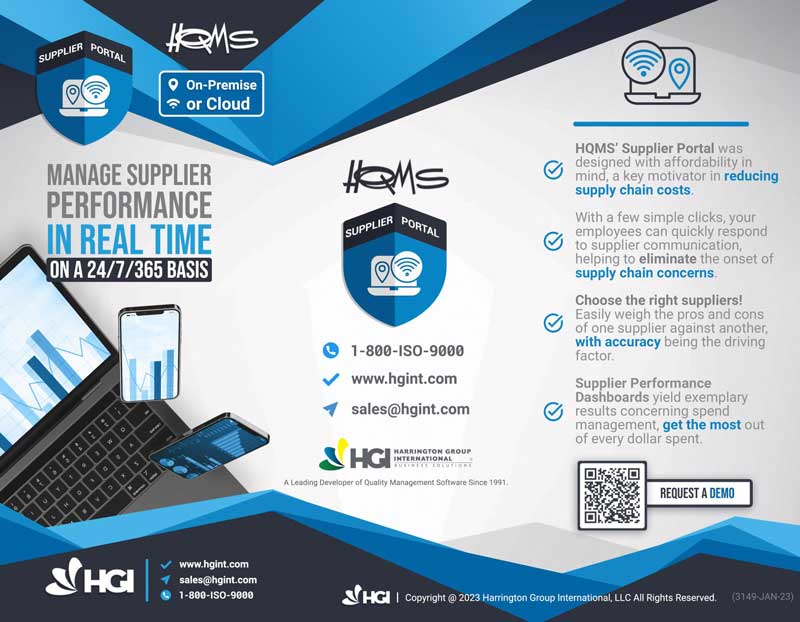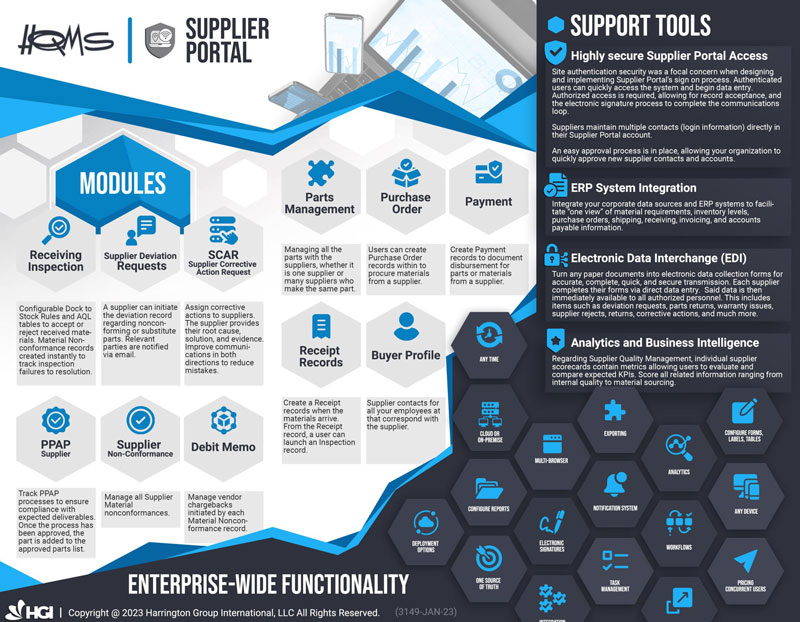Supplier Management Software for Supply Chain Management
Call us today at: 1-800-ISO-9000 to find out more on our software
Harrington’s Supply Chain Management Software System
Improving communication with suppliers can be a significant challenge. Still, the HGI Supplier Collaboration Portal smooths communication, creates a single point for tracking comments and complaints and provides accountability between your organization and your suppliers. Integration with your ERP and QMS further improves its value to your suppliers and your own business.
HQMS incorporates core quality management applications for CAPA, Document Management, Audit Management, Complaint Management, and Training Management. It also takes a “cloud native” approach with the Supplier Collaboration Portal to make it easier for the end user to effectively manage and collaborate with suppliers and contract manufacturers across your supply chain.
Take advantage of new modules in the Supplier Collaboration Portal for SCARs, PPAP, Purchase Orders, Payments, Receipts, Receiving Inspections, Supplier Deviations, and more. In addition, edge computing allows integration to data processing and ERP models such as Oracle and SAP.
HQMS offers the latest in cloud-based, agile, SAAS, CAAS, and edge computing technologies.
Why Supply Chain Management Can Be Difficult:
When it comes to managing your suppliers, it is vital that you have precise records. It is safe to say that even the best record-keeping may not always be enough to make Supply Chain management simple. Unquestionably, managing suppliers can be a challenge. This is especially true as your business grows.
A small business may have to manage just one or two suppliers, for example, and this can be quite simple. However, businesses that deal with multiple suppliers across multiple divisions at any one given time, may find themselves starting to struggle.
This is inevitable as your business starts growing! With more orders and more suppliers, things can get muddled. It is easy to find yourself wondering which supplier is providing which service! Confusion will amass, leading to negative consequences to your customer, team, and overall business.
Supplier Chain Management Difficulties:
What do we mean? Well, think of it this way. Let’s imagine your business has been running like clockwork up until this point. All your suppliers have been effectively managed by you or your business’ staff. Then, out of the blue, something goes wrong! What could this be? There are so many various things that could go wrong when it comes to suppliers.
For example, if by sheer coincidence three of your suppliers contact your business on the same day to inform you that a supply issue on their end has halted their production, causing them to not be able to get the next order to you. This confusion can create an enormous number of challenges. Which suppliers do you prioritize for getting the supplies to your business? Which supplier is responsible for which product, and which supply issue will impact your business operation the most? This type of issue can lead to a vast number of questions, and in turn, you might find yourself feeling overwhelmed. This causes mistakes to be made more readily, thereby causing a slippery slope effect, negatively impacting your business.
Investing in a Supply Chain Software Solutions Can Help:
Managing suppliers is a complex process. The difficulties with supplier management grow exponentially as your business builds, causing many various problems and challenges. Even if your business expands your supplier management department size, you can still be certain that mistakes will be made by your staff! They are only human, naturally subject to human error.
There is a way that you can limit the number of mistakes being made and optimize your supplier management. It is by investing in premium-quality supplier management software! Here at Harrington Group International, we have created a supplier management software solution that promotes a consistent communication channel, creating a single point for tracking comments and complaints, and providing accountability between your organization and your suppliers. Integration with your ERP and QMS further improves its value to your suppliers and your own business.
Supplier Collaboration Portal - Product Benefits

There are various aspects in which supply chain management software can be a great investment for your business. We’ve outlined some of the most important benefits below, but how your company uses the software is customizable! The benefits are limitless to your imagination!
- Great value for your money and services! At the end of the day, your business exists to be profitable while delivering on its goals and objectives. As such, Supply chain management solutions need to be reasonably priced. We have taken affordability into consideration while developing solutions. Our supplier management software is affordable to purchase and serves to help reduce costs in your Supply chain management department. Additionally, the software also makes their responsibilities easier to complete, thus improving efficiency and productivity.
- Reducing mistakes and enhance the supply chain! Your business’ Supply chain management staff have an enormous job to do. Providing them with the Supply chain management solutions they need will help them do their jobs better. This software will ensure that your staff manages business suppliers successfully, helping to reduce supply chain concerns. An efficient software will also boost your supply management department’s morale, creating a win-win solution for all!
- Better spending management with suppliers! Some suppliers represent better value for money than others for your business. Luckily, HGI’s supplier collaboration portal can help give visibility to how expenses are being made, giving your staff an insight into how to better optimize these supplier expenses. Better optimization of expenses will save your business money and increase its profitability!
- Compare suppliers! It may seem tough to compare suppliers on paper, but our supplier collaboration software can help your business to compare the pros and cons of different suppliers quickly, easily, and accurately. Make sure you are working with the right suppliers!
If you need the various divisions of your business to run smoothy, things can be a little more complicated than they seem. If your business deals with multiple suppliers throughout your various business divisions, staying atop of your suppliers can be a major challenge. After all, we are only human and have a certain capacity before needing a little help.
Luckily for your business, if you need help with managing your suppliers, there is now a perfect solution for you to Demo! Our software is designed for businesses just like yours!
We understand the importance of getting Supply chain management right, but we also know what a challenge this can be to do alone. If you have been considering a way to enhance your business management, don’t delay! Let our team help!
Time is of essence! If you think that a vendor management software could be a viable solution for your business, it is imperative that you invest as soon as possible to begin seeing the changes your business needs today! There are many various benefits to investing in HGI’s Supplies Chain Management Software such as, but not limited to, fewer mistakes, directly compare various suppliers, and superior expense management. So, don’t delay!
Our Software Capabilities
Our solution will consolidate all inventory and supplies data and activities in a fully secured, searchable database accessible across your firm. Also, it helps you to maintain and manage supplies contact information, report audit results, performance ratings, standard certifications, and vendor contracts. Our Software will be the ultimate trendsetter of your supply chain and its automatic notifications of records of supplies nonconformance (NCRs) along with its ability to implement and track corrective actions (CARs) enhances total supply chain performance of your enterprise.
Eliminating risk across your supply chain is our core goal and for that purpose, we have provided you inbuilt applications in the solution that will show Key Performance Indexes (KPIs) of your supplies based on which you can take an informed decision about the vendor management.
While reducing supply chain risk and possible disruptions, we offer to boost your overall efficiency levels at every stage of the production process by lowering costs, improving decision making and communication among internal business units and also with external supplies.
If you are ready enough, you can exploit total savings derived from our supplies management software for innovations of your product and improving service quality. More importantly, you can comply with ISO standard requirements and compliance related to vendor management.
Why our supplies & inventory management software is the best?
Our solution:
- is not just an application, it is a functional business platform all involved in the supply chain and can work simultaneously
- comes with all essential tools and supplies information management such as data collection and workflow, supplies performance assessment, supply chain risk management
- comes with advanced features for supply relationship management, e-sourcing and procurement and contract management
- has advanced analytical tools to assess all the supplies data statistically to make informed decisions.







